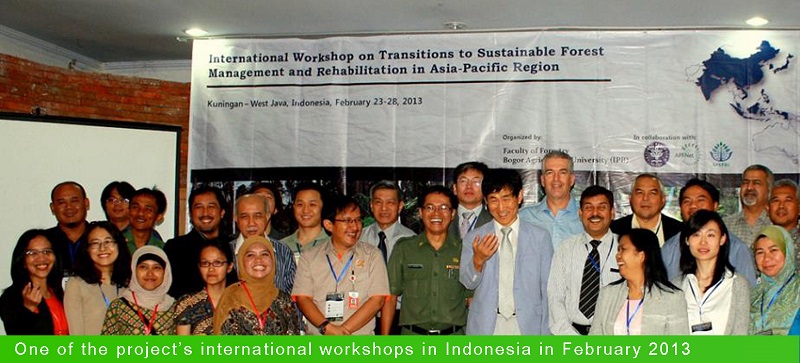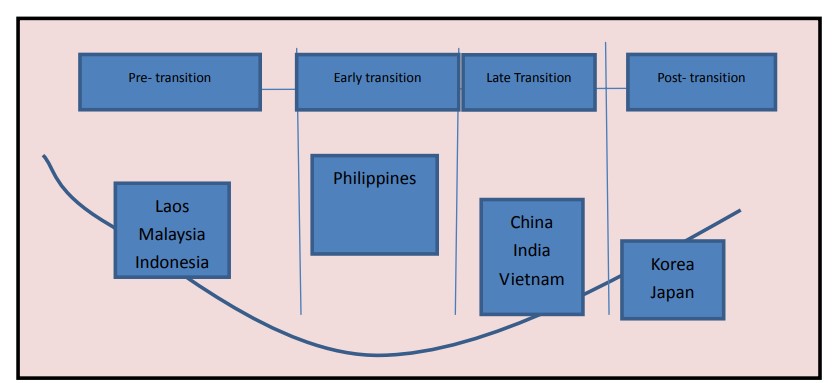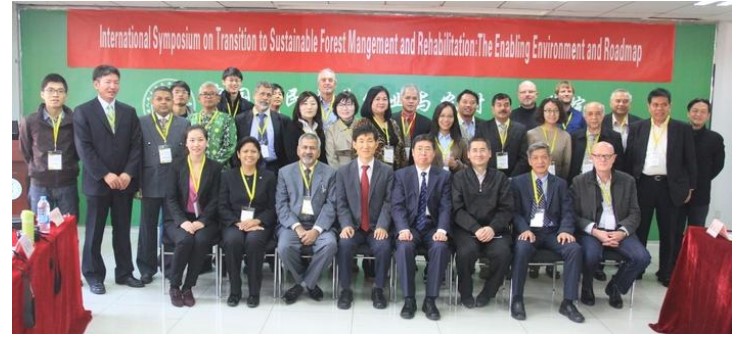
Project title: Comparative Analyses of Transitions to Sustainable Forest Management and Rehabilitation
Executing agency: Asia Pacific Association of Forestry Research Institutions (APAFRI)
Project Core Team: Three Technical Assistance Partners of Renmin University of China (RUC), Seoul National University (SNU), and Kyoto University (KU)
Budget in USD (total/APFNet grant): 317,500/ 268,000
Duration: 11/2011-12/2013
Project Category: Research and Policy Development Project
Target economies: Nine economies in the Asia Pacific region: China, South Korea, Japan, India, Indonesia, Laos, Malaysia, Philippines, and Vietnam
Objectives:
Outputs:
Output 1: To complete the framework of economy case studies and their forest transition analysis.
Output 2: To complete comparative analyses framework and categorization models.
Output 3: To strengthen regional capability and capacity in reducing deforestation, induce rehabilitation, and foster sustainable forest management.
Activities
Activity 1.1.1 - 1.1.3: Identify case study economies and leading experts for each economy and arrange the project inception meeting and training workshop on the forestry transition study.
Activity 1.2.1 & 1.2.2: Conduct economy case studies and mid-term review of the economy case studies progress.
Activity 2.1.1 – 2.1.3: Formulate framework for comparative study, conduct comparative analysis on forest transition study, and organize three-day mid-term project meeting.
Activity 2.2.1: Categorize models based on the primary case study reports.
Activity 3.1.1 – 3.1.2: Brief policy for reducing deforestation and publish a book on forest transition in the Asia-Pacific Region.
Activity 3.2.1 – 3.2.3: Organize master students co-sharing learning programme and organize an international conference on forestry transition in Asia-Pacific Region.
Project background
Forests play a vital role in sustainable development, providing economic, social, and environmental benefits, including essential ecosystem services such as climate change mitigation and adaptation. The worsening global climate change and other environmental issues have been calling for a better understanding and the reduction of deforestation and the enhancement of forest rehabilitation. Deforestation and forest transition are generally driven by complex social, economic, and political factors. However, studies on these matters of the last two decades have usually failed to provide workable models and tools leading to concrete policy recommendations that can effectively be used to achieve the intended objectives of reducing deforestation and inducing forest rehabilitation towards achieving sustainable forest management.
The Asia-Pacific region is rich in forest resources and experiences diverse and complex deforestation processes and initiates approaches for forest rehabilitation as well. Therefore, the Asia Pacific Association of Forestry Research Institutions (APAFRI) implemented this project titled “Comparative Analyses of Transitions to Sustainable Forest Management and Rehabilitation” in technical collaboration with the Renmin University of China (RUC), Seoul National University (SNU) and Kyoto University (KU). The goal of the project is to identify factors contributing to forest cover changes in several economies in the Asia-Pacific region. A better understanding of the impacts of these factors aims to help formulating strategies and policies to reduce deforestation, induce forest rehabilitation, and foster sustainable forest management. For the case studies, economies with a net forest cover increase and economies that still experience a decline were selected. Economies with both areas of forest reduction and areas of forest recovery were also considered appropriate candidates for case studies. Case studies and national reports were commissioned for nine economies: China, South Korea, Japan, India, Indonesia, Laos, Malaysia, Philippines, and Vietnam (Fig.1).

Fig.1 Case studies were commissioned for nine economies: China, Japan, South Korea,
India, Indonesia, Laos, Malaysia, Philippines, and Vietnam
Project featured topic
Direct and indirect drivers of deforestation in the project economies
Forest transition is a process from net deforestation to net reforestation. China, India, Japan, South Korea, Vietnam, and Philippines belong to the selected economies that have experienced forest transition, whereas in Indonesia, Laos and Malaysia deforestation is still prevailing. The drivers of deforestation are divided into proximate (direct) causes and underlying (indirect) causes.
In Indonesia, Laos, Malaysia, and the Philippines, illegal logging is one of the main direct drivers of deforestation and forest degradation, whereas it has less of an impact in Japan, South Korea, India, Vietnam, and China.
The economies of Indonesia and Malaysia are especially affected: Illegal logging reached 70–80% of Indonesia's total timber production, which included 60% of the country's hardwood production. Hence, 100% of log exports, 65% of lumber exports, and 55% of plywood exports from Indonesia stem from illegal logging activities. In Philippines, logging either legally or illegally was found to account for 41% of deforestation; followed by shifting cultivation by indigenous people (17%), natural calamity (13%), mining (8%), charcoal making (8%), fuelwood gathering (4%), and conversion of forest for farming (3%). Government mismanagement is one of the underlying, indirect causes of deforestation and forest degradation in Asia. Illegal logging and high rates of deforestation in Indonesia, Laos, Malaysia, Vietnam, and Philippines were caused by government mismanagements including corruption, weak enforcement and monitoring capacity, and rent-seeking behaviour. Illegal logging in China accounted for 500 thousand cubic meters in the 1990s. However, China has taken strict legal measures including forest policies, forest station and timber check point, in the late 1990s to protect and expand its forests. After an integral forest administration system was developed, illegal timber logging significantly decreased.
The indirect causes of deforestation in Asia economies are complicated and include a combination of institutional, international policy, economic development, and demographic factors. It was found that economies in forest transition and economies in non-forest transition have different underlying causes of deforestation. The rapid decline in forest cover in tropical economies like Indonesia, Malaysia, Philippines, Laos, and Vietnam was caused by a combination of factors, through not to the same extent as in Japan, China, South Korea, and India. This included population migration, an export-oriented economy structure in agriculture and forestry, government failures in managing the forest, and chaotic forest land ownership. Therefore, to find a solution to deforestation requires the adjustment of economic development strategy, policy, and institutional changes.
Classification by forest transition stage
National-scale statistical modelling has shown that forest area changes in Asia-Pacific economies were due to a combination of economic and political responses to forest and land scarcity, economic growth, and international market integration. Forest areas in China, Japan, Korea, and Vietnam had grown in the take-off stage of industrialization rather than after industrialization. Despite being at the early stage of forest transition, forest cover in the Philippines increased during the very early stage of industrialization. Therefore, the nine participating economies can be divided into four phases, as shown in Fig.2. Laos, Malaysia, and Indonesia could be classified as pre-transition economies. The Philippines is in the stage of early transition. India, China, and Vietnam are in the late transition stage, and Japan and Korea are in the post-transition stage. China, India, and Vietnam experienced a significant increase in their forest area in the last three decades. The forest transition in these economies contributes to global carbon sequestration, biodiversity conservation, and local and regional environmental improvement.

Fig.2 Four phases of the forest transition (FT model), with the graph representing the first decreasing(pre-transition stage)
and then increasing (late and post- transition stage) forest area in the respective economies
Project Outcomes
According to the analysis of forest transition in the nine project economies, afforestation initiatives were important driving forces to realizing local forest transition. The combined forest area in the participating economies appears to have increased by 32 million ha, or 7%, between 1990-2010. This might be attributed to the contribution of increases in forest area in China (50 million ha, 32%), Vietnam (4.4 million ha, 47%) and India (4.5 million ha, 7%), respectively. However, 20% of the forest cover in Indonesia was lost, which means the deforestation of 21 million ha; furthermore, 9% of forest area was lost in Malaysia and Laos, respectively, during this period. Significant achievements have been made in forest generation and conservation in China, India, Japan, Korea, and Vietnam.
With one-fifth of the world’s population and 5% of global forests, the recent rapid development, moderate development stage, and a better understanding of forest transition in China have great significance to China and the world. Contemporary China has to restructure the economy and reform the social and political system to safeguard the environment, harmonize the natural and social economic system in China as well as address the challenge of limits of natural resources, and pursue a new paradigm of development- so-called ecological civilization.
Forest transition in Asia results from a combination of political, social, institutional, and economic factors. Forest transition was complicated by economic development. However, as the analysis demonstrated, urbanization and increasing off-farm employment have been strongly emphasized in Japan, South Korea, China, and India as a way to reduce pressure on forests and promote spontaneous reforestation in marginal cultivated land, but they have received less attention in non-forest transition economies of Vietnam and Philippines. As a result, economic growth was required for the forest transition. Understanding political economy, social culture, and numerous other views was necessary to fully explain the forest transition in Asia, as opposed to focusing on a single perspective. China, India, Japan, South Korea, and Vietnam demonstrated that favourable government policy and appreciative institutionalized management rules play a critical role. The direct involvement of the government in a forest transition economy by implementing large-scale national forestation programs, strengthening forest policy systems and forest governance, carrying out decentralization reform, and adopting timber import liberalization policy, played a primary and essential role in promoting the forest transition in Asian economies.
For the purpose of capacity building, the international symposium on “Transition to Sustainable Forest Management and Rehabilitation: The Enabling Environment and Road Map” was successfully organized by the Renmin University of China on 21-23 October 2013 (Fig.3). The symposium was attended by representatives from the participating economies in the Asia-Pacific Region, as well as representatives from the three Technical Assistance Partners who also presented keynotes in the symposium. The aim was to report on the output of the project and finalize the reports, as well as reports of the case studies from the participating economies, concluded by a field visit to the Badaling Forest Farm and Badaling Great Wall in Yanqing County, Beijing.

Fig.3 International Symposium on Transition to Sustainable Forest Management and Rehabilitation:
The Enabling Environment and Roadmap at the Renmin University of China
The findings of the project could assist governments in formulating strategies and policies that benefit all stakeholders. Comparative analyses using data/information from the nine participating economies will be continued beyond the completion of the present project.
The coordination within the region is required to develop a fair-trade policy to reduce the negative impact of globalization on those economies with rich forest resources. It is necessary to continue strengthening forest governance, improving forest policy, and promoting decentralization of forest management and stakeholder participation.
 Project documents
Project documents
2011P6-APAFRI Project proposal
2011P6-APAFRI Project completion report
 News and related information
News and related information
The Project Inception Meeting: Comparative Analyses of Transitions to Sustainabl e Forest Management and Rehabilitation
Comparative Analyses of Transitions to Sustainable Forest Management and Rehabilitation
 Publications
Publications
Comparative analyses of transistions to sustainable forest management (2014)
Economic globalization, trade and forest transition-the case of nine Asian countries
Conditions of forest transition in Asian countries
Comparative study of the forest transition pathways of nine Asia-Pacific countries
Assessment of bio-physical, social and economic drivers for forest transition in Asia-Pacific region